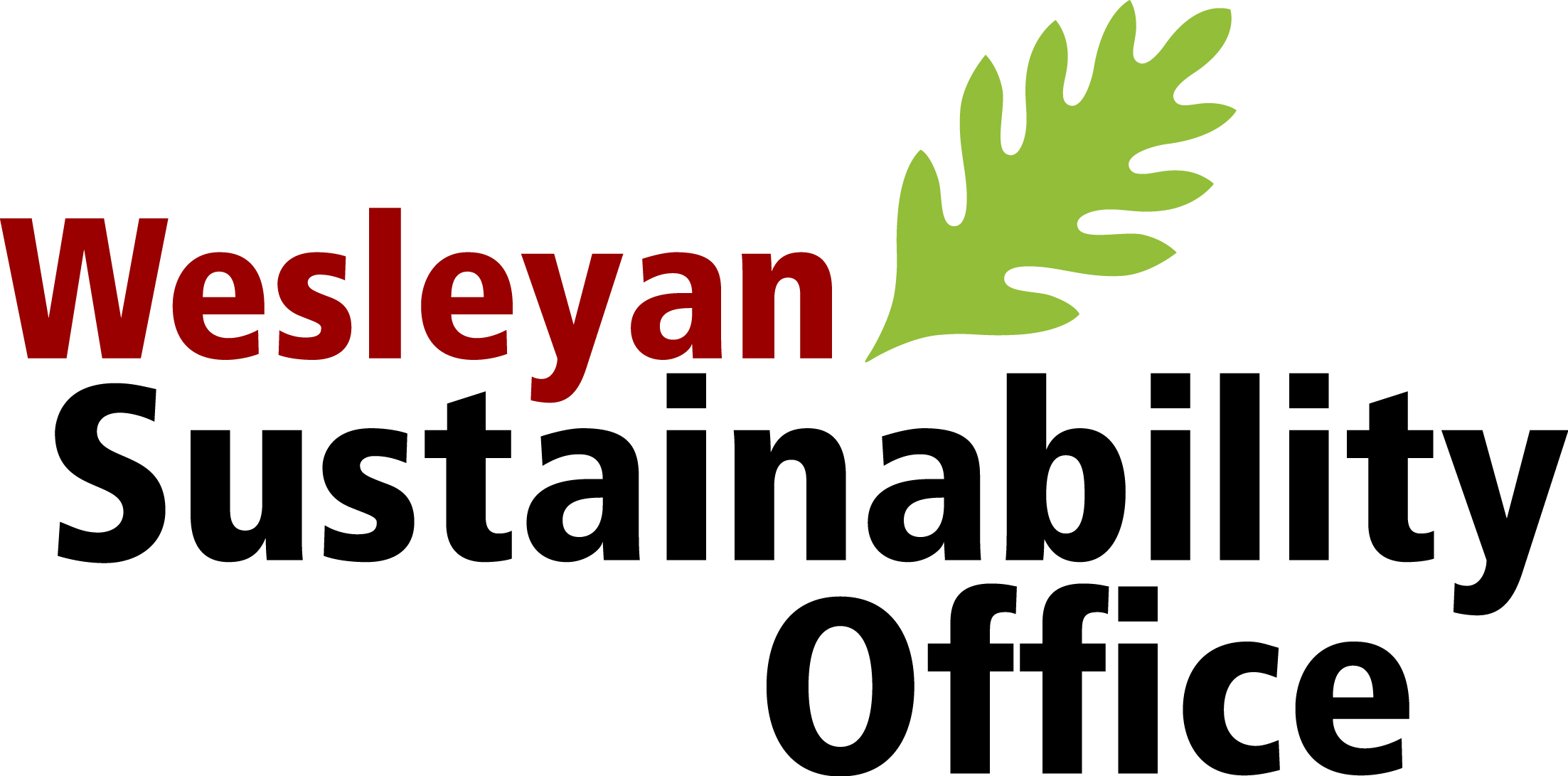Energy
Emissions generated as a result of energy consumption (electricity, heating, and cooling) represent over 75% of Wesleyan's carbon pollution. To neutralize these emissions, we are working to:
- Electrify campus heating and cooling and install renewable energy capacity through the utilities carbon neutrality master plan.
- Keep temperatures lower in winter and higher in summer through the Energy Conservation Policy.
- Reduce energy use as much as possible through conservation and efficiency initiatives.
- Build to energy-efficient standards with the Building Sustainability Policy.
- Promote behavior change through the Green Office Program, Green Dorm Program, and Sustainability Office Student Interns.
Energy Consumption Data
Wesleyan's campus is divided into the core campus (most large buildings) and non-core campus (includes smaller offices/departments and woodframe houses). The graphs and descriptions below show trends in energy consumption by fuel type from calendar year 2020 - 2024.- Electricity, Gas, & Oil Consumption
Electricity, Gas, and Oil Consumption (2020-2024)
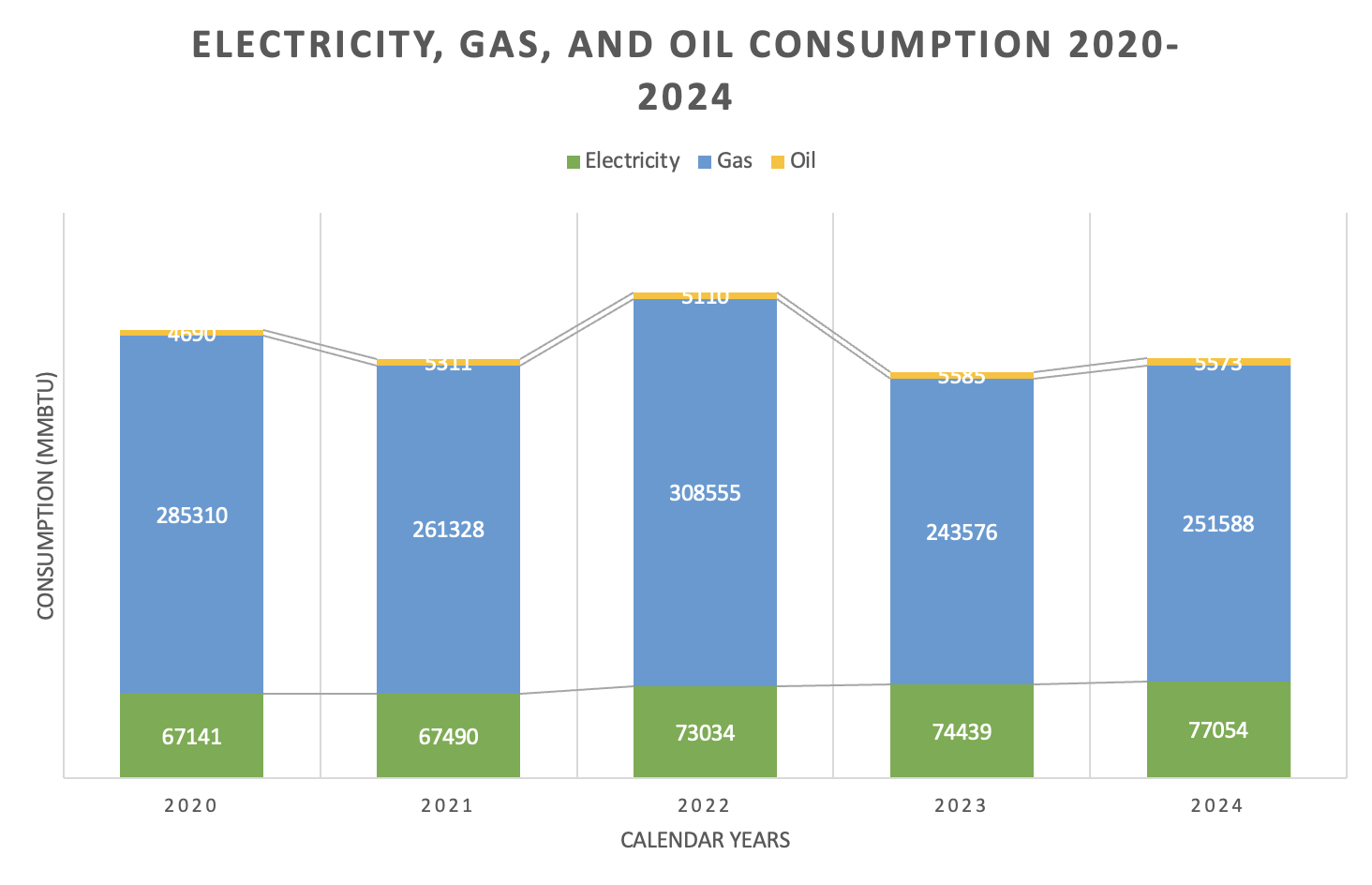
Trends
- Electricity Consumption:
- Shows a gradual increase over the years, starting at 67,141 MMBtu in 2020 and reaching 77,054 MMBtu in 2024.
- This steady rise suggests increased electricity use over time.
- Gas Consumption
- Fluctuates over the years, peaking at 308,555 MMBtu in 2022 and then declining to 243,576 MMBtu in 2023.
- Shows some recovery in 2024 at 251,588 MMBtu, but it remains lower than its 2022 peak.
- Oil Consumption:
- Has a smaller contribution compared to electricity and gas but follows a generally increasing trend.
- Starts at 4,690 MMBtu in 2020, peaks at 5,585 MMBtu in 2023, and slightly decreases to 5,573 MMBtu in 2024.
Overall, gas remains the dominant energy source, though its consumption fluctuates over the years. Electricity consumption shows a consistent increase, indicating a growing reliance on electrical energy. While oil consumption is relatively minor in comparison, it exhibits a general upward trend over time.
- Electricity Consumption:
- Electricity Consumption (2020-2024)
Electricity Consumption (2020-2024)
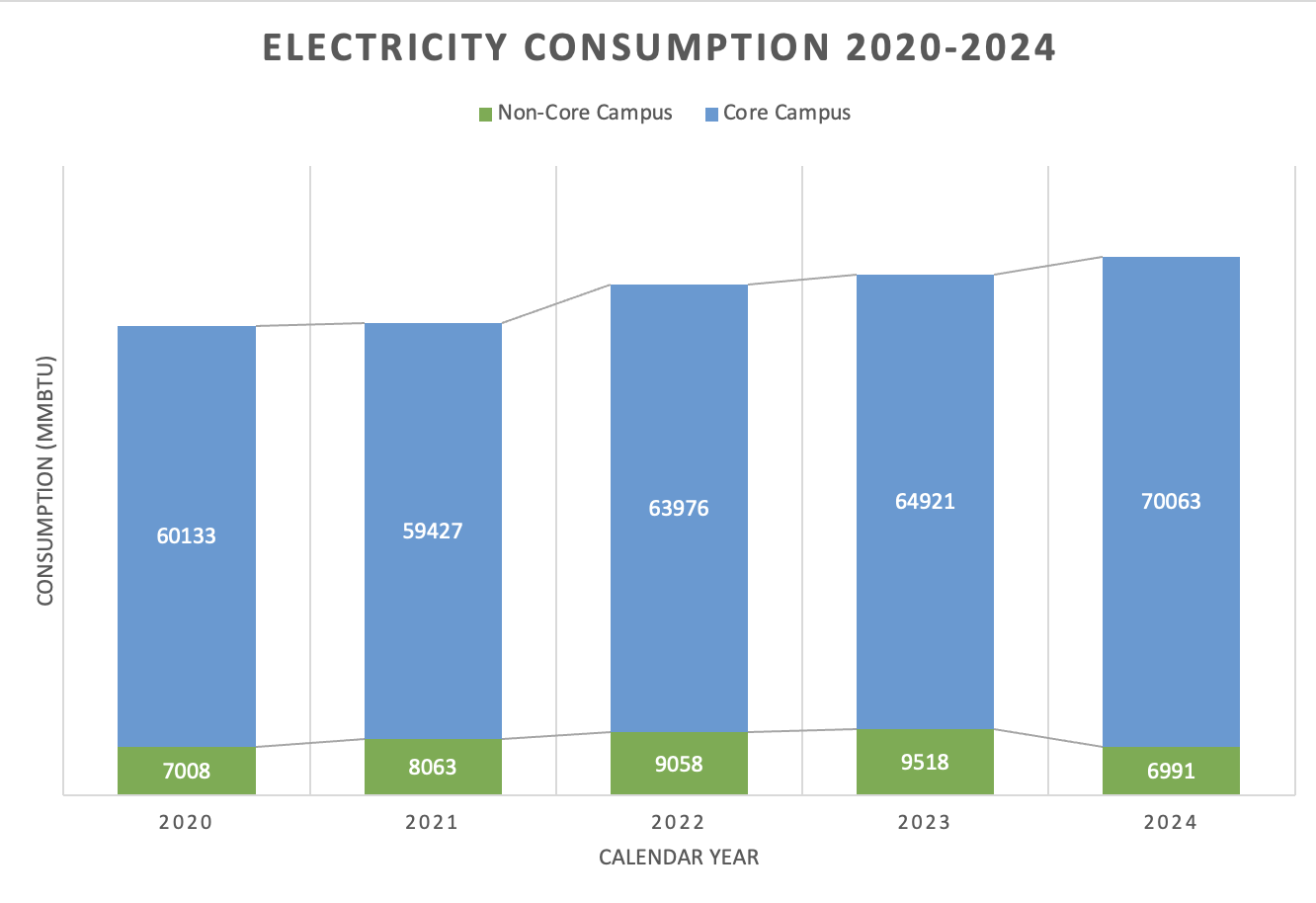
Trends
The graph presents electricity consumption trends for both the core and non-core campus areas from 2020 to 2024.- 2020: Electricity consumption was at 67,141 MMBtu, with the core campus accounting for the majority (60,133 MMBtu).
- 2021: Total consumption remained relatively stable at 67,490 MMBtu, with a slight increase in non-core campus usage.
- 2022: Consumption increased to 73,034 MMBtu, suggesting greater energy demand, possibly due to expanded operations or higher occupancy levels.
- 2023: Electricity usage rose further to 74,439 MMBtu, continuing the trend of increased energy demand across campus.
- 2024: Consumption peaked at 77,054 MMBtu, marking the highest level in the five-year period, driven primarily by core campus usage.
Overall, the data indicates a steady increase in electricity consumption, particularly in the core campus. This upward trend could be attributed to campus expansion, increased student activity, or additional energy-intensive operations (primarily due to electrifying heat load and hot water load).
- Gas Consumption (2020-2024)
Gas Consumption (2020-2024)
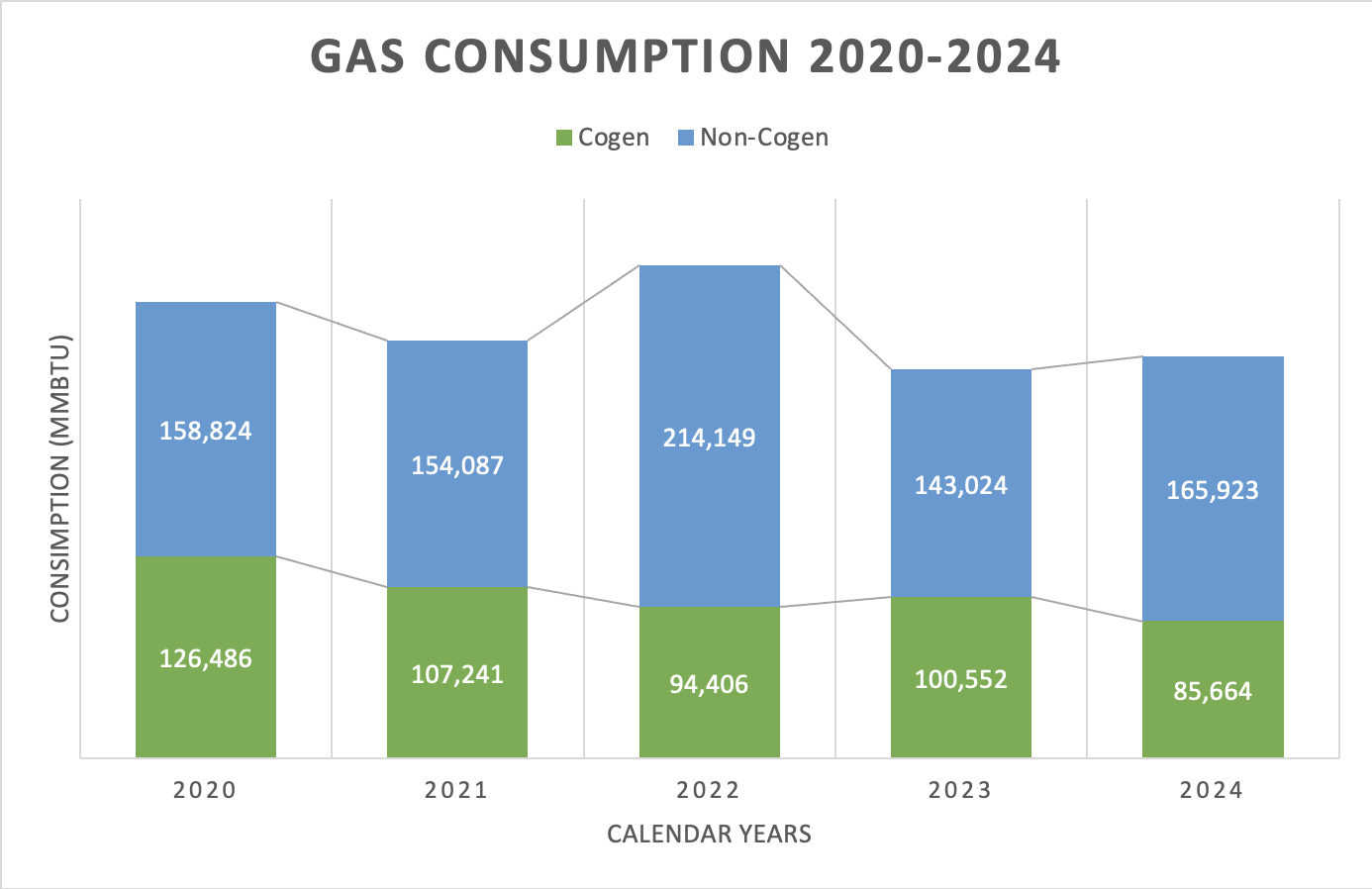
Trends
The graph displays gas consumption trends for both cogeneration (Cogen) and non-cogeneration (Non-Cogen) from 2020 to 2024.- 2020: Total gas consumption was 285,310 MMBtu, with 158,824 MMBtu from Non-Cogen and 126,486 MMBtu from Cogen.
- 2021: Consumption decreased to 261,328 MMBtu, driven by a reduction in Cogen usage to 107,241 MMBtu.
- 2022: Total consumption peaked at 308,555 MMBtu, with Non-Cogen usage rising significantly to 214,149 MMBtu while Cogen continued to decline to 94,406 MMBtu.
- 2023: Gas consumption dropped to 243,576 MMBtu, with Non-Cogen decreasing to 143,024 MMBtu while Cogen slightly increased to 100,552 MMBtu.
- 2024: Total gas consumption rose again to 251,587 MMBtu, primarily due to an increase in Non-Cogen consumption to 165,923 MMBtu, while Cogen reached its lowest level in the five-year period at 85,664 MMBtu.
Overall, gas consumption fluctuated over the five-year period, with a peak in 2022 followed by a decline in 2023 and a partial rebound in 2024. The trend indicates a shift away from cogeneration toward higher reliance on non-cogeneration gas consumption.
- Oil Consumption (2020-2024)
Oil Consumption (2020-2024)
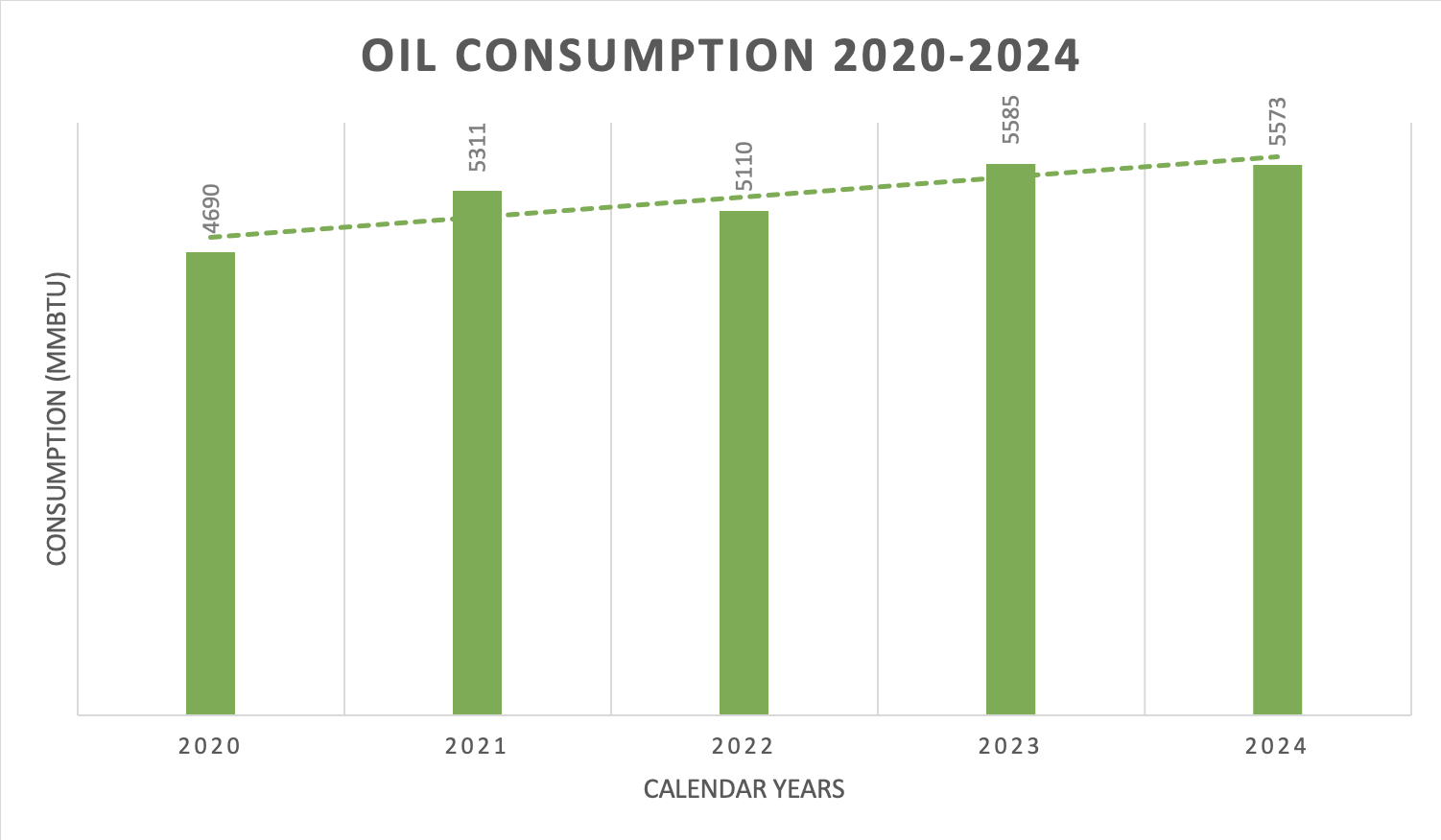
Trends
The graph illustrates oil consumption from 2020 to 2024, showing a general upward trend in usage.- 2020: Oil consumption was 4,690 MMBtu.
- 2021: Consumption increased to 5,311 MMBtu, primarily due to the purchasing of 55 High St.
- 2022: A slight decline occurred, with consumption dropping to 5,110 MMBtu.
- 2023: Consumption peaked at 5,585 MMBtu.
- 2024: Oil consumption remained high at 5,573 MMBtu.
Overall, the data suggests a gradual increase in oil consumption over the five-year period, with minor fluctuations. The upward trend may indicate a growing reliance on oil or increased energy demands over time.
What We've Done
- Energy Conservation
- To promote environmental, financial, and social sustainability, Wesleyan adopted an Energy Conservation Policy in 2014. This policy establishes temperature ranges in all campus buildings that conserve energy while promoting comfort. Compliance with the policy is included in the Green Office Certification.
- Nest thermostats have been installed in many campus buildings not connected to the campus microgrid, with plans for further installation.
- An employee daytime computer backup system means that nearly all employees can turn off computers each night.
- Default wallpaper in all classroom computers reminds users to turn off projectors while not in use.
- Stickers are in most classrooms reminding occupants to turn off projectors, turn down heat/AC, close windows, and turn off lights.
- ITS and Facilities redesigned and consolidated the campus data center to reduce the amount of cooling required.
- ITS employs a cloud-first philosophy. Only services that require being on-premises for security, access, and/or cost considerations are in the data center. For those services on premises, ITS is heavily invested in virtualization technologies and consolidated storage solutions.
- Energy Efficiency
- Since 2005, Wesleyan has completed energy efficiency and conservation improvements through annual projects, including occupancy sensors, lighting improvements, energy metering, insulation, heating/cooling equipment replacements, and installing Variable Frequency Drives (VFDs) to reduce electrical motor consumption of air handlers and hot water pumps.
- An energy management system monitors and manages energy consumption. Most buildings are equipped with the capability to set back temperatures at night and on weekends.
- In 2011-12, all of Wesleyan's woodframe residences and administrative offices located in former houses had energy assessments through Energize Connecticut’s Home Energy Solutions program. Over 100 faculty and staff also took advantage of this program. Houses added to Wesleyan's portfolio since the original assessments were assessed in Summer 2015.
- Energy Sourcing
- From FY 2020 - FY 2023, Wesleyan purchased wind Green-E certified RECs (renewable energy credits) to offset 100% of purchased electricity usage. This was discontinued in FY 2024 due to high costs.
- A utilities carbon neutrality master plan has created a roadmap for ways to reduce campus energy use and power 100% of heating, cooling, and electricity needs within the campus microgrid (central campus) through renewable energy sources. Wesleyan is investigating funding opportunities for this plan and for ways to expand these efforts to buildings not connected to the microgrid.
- Solar photovoltaic (PV) installations are located at Long Lane (750 kW, installed 2016), Freeman Athletic Center (200 kW, installed 2012), 19 Fountain Avenue (7.2 kW, installed 2008), and Admissions (3 kW, installed 2008) to add renewable energy to New England's grid and prepare Wesleyan long-term for carbon neutrality. Another PV array will be installed at Neighborhood Preschool in 2023.
- A natural gas cogeneration systems is located at the Central Power Plant (2.4 MW, installed 2009).
- Since 2013, Wesleyan has purchased B20 biofuel (80% #2 oil, 20% recycled cooking oil) from Portland-based Hale Hill Biofuels for campus buildings run on oil. Biofuel replaces all Wesleyan's oil purchases and has a lower carbon footprint than #2 oil.
- In 2015, Wesleyan was one of six Connecticut schools participating in Solarize U, a solar discount program run by the state. Through the installation of solar panels on employee and alumni homes, this program gave Wesleyan community members the opportunity to reduce monthly electric bills and carbon footprints.
- A solar rover for powering events was designed and built by the Sustainability Coordinators, and launched for outdoor campus events in Fall 2020.
Energy Conservation Policy
Wesleyan's Energy Conservation Policy, established in 2014, sets temperature ranges in all campus buildings to conserve energy while promoting comfort.
Temperature Ranges
Buildings without reheat |
Buildings with reheat |
||
|
All temperatures ± 2°F unless noted |
|||
| Summer | Occupied | 75° | 74° |
| Unoccupied | 77° | 69° | |
| Winter | Occupied | 68° | 70° |
| Unoccupied | 65° (min.) | 65° (min.) | |
Buildings with reheat have systems that cool down incoming air to dehumidify it and then reheat it to the desired temperature. In these buildings, not reheating air saves energy, so these buildings have cooler summer temperatures than buildings without reheat. Reheat buildings include Boger, Allbritton, Fisk, Olin, Usdan, Fayerweather, and the Science Library.
Night and weekend setbacks for administrative and academic spaces are set on a building-by-building basis to accommodate building schedules. Temperatures will not be adjusted for individuals entering a building during unoccupied hours.
Comfort Suggestions
To maximize your personal comfort and energy efficiency:
- Do not use a space heater unless it is needed to maintain temperatures within the ranges above. A heating mat is more effective at keeping you warm with lower energy usage (up to 95% less energy than a space heater). Learn more about the energy savings of a heating mat.
- Wear seasonally appropriate clothing and dress in layers. Shorts will be permitted in the summer.
- Keep furniture at least 6 inches from all thermostats and vents.
- Move computers, lamps, and other heat-generating equipment away from the thermostat.
- Adjust blinds based on season and time of day.
- Close windows and exterior and vestibule doors if heat or air conditioning is on.
- Put down storm windows during the winter (if applicable).
- Use table or floor fans for additional cooling.
- Swap workspaces with a coworker.
Contact
Andrew Plotkin, Project Engineer
